The industrial evaporative condenser market, valued at USD 232.2 million in 2025 and projected to reach USD 400.4 million by 2035, is forecast to expand at a CAGR of 5.6% over the period, translating to a total addition of USD 168.2 million. This nearly 1.72X increase shows the consistent adoption of evaporative condensers across industrial cooling applications. While volume adoption anchors the baseline expansion, technological innovation and selective pricing dynamics serve as accelerators of value creation, particularly in the latter half of the decade.
Between 2025 and 2030, volume growth is expected to dominate, largely fueled by surging demand in HVAC, refrigeration, and process cooling systems. Expanding industrial facilities in chemicals, food and beverage, and power generation sectors are turning toward evaporative condensers for their superior heat rejection efficiency and operational reliability. The replacement cycle of outdated cooling infrastructure is also expected to contribute significantly, especially in North America and Europe, where compliance with energy and environmental standards continues to tighten. These factors make the early years of the forecast period volume-intensive, with manufacturers focusing on scaling production to capture demand across both mature and developing markets.
From 2030 to 2035, the growth composition shifts toward a blend of volume expansion and incremental pricing contributions. Emerging markets in Asia-Pacific, the Middle East, and Latin America are set to lead installation activity due to rapid industrialization and infrastructure investments. At the same time, premiumization strategies will gain traction as buyers increasingly prefer condensers with advanced features, such as corrosion-resistant coatings, modular configurations, and smart monitoring capabilities. These value-added attributes are expected to enable suppliers to achieve price gains while maintaining competitiveness. The introduction of compact and high-efficiency designs will also help manufacturers capture niche opportunities in sectors with space and energy constraints, such as urban industrial facilities and advanced manufacturing plants. Technological adoption forms another critical pillar in the industrial evaporative condenser market’s progression, with ongoing R&D driving improvements in energy efficiency, water usage optimization, and durability. Innovations in material science are making condensers more resilient in harsh industrial environments, while digital integration is allowing predictive maintenance and remote monitoring to enhance lifecycle management. Suppliers leveraging these advances will be able to differentiate offerings and strengthen their position in a market where traditional cost-based competition is giving way to performance-led value.
| Period | Primary Revenue Buckets | Share | Notes |
|---|---|---|---|
| Today | Counterflow evaporative condensers | 52% | Traditional cooling systems, established industrial facilities |
| Combined crossflow systems | 31% | Multi-stage cooling applications, process industries | |
| Specialty cooling configurations | 17% | Custom applications, high-performance requirements | |
| Future (3-5 yrs) | Advanced counterflow systems | 45-48% | Enhanced efficiency, automated controls |
| High-performance combined systems | 28-31% | Integrated cooling solutions, process optimization | |
| Chemical processing applications | 15-18% | Specialized chemical industry cooling | |
| Pharmaceutical manufacturing | 8-12% | Precision temperature control, GMP compliance | |
| Power generation cooling | 6-10% | Utility scale applications, energy sector | |
| Custom & specialty systems | 4-8% | Engineered solutions, niche applications |
| Metric | Value |
|---|---|
| Market Value (2025) | USD 232.2 million |
| Market Forecast (2035) | USD 400.4 million |
| Growth Rate | 5.6% CAGR |
| Leading Configuration | Counterflow Systems |
| Primary Application | Chemical Processing Segment |
The industrial evaporative condenser market demonstrates strong fundamentals with counterflow condenser systems capturing a dominant share through advanced heat transfer properties and industrial application optimization. Chemical processing applications drive primary demand, supported by increasing energy efficiency requirements and industrial cooling system modernization initiatives. Geographic expansion remains concentrated in developed markets with established industrial infrastructure, while emerging economies show accelerating adoption rates driven by manufacturing sector modernization initiatives and rising energy efficiency standards.
Primary Classification: The market segments by configuration type into counterflow, combined crossflow, and others, representing the evolution from traditional single-stage cooling to sophisticated multi-stage systems for comprehensive thermal management optimization.
Secondary Classification: Application segmentation divides the industrial evaporative condenser market into chemical, pharmaceutical, electric, heat treatment, and others, reflecting distinct requirements for cooling performance, temperature control precision, and process integration specifications.
Tertiary Classification: End-use segmentation covers process manufacturing facilities, power plants, chemical refineries, pharmaceutical companies, and industrial cooling contractors, while distribution channels span direct sales, equipment distributors, and specialized industrial suppliers.
Regional Classification: Geographic distribution covers North America, Latin America, Western Europe, Eastern Europe, East Asia, South Asia Pacific, and Middle East & Africa, with developed markets leading adoption while emerging economies show accelerating growth patterns driven by industrial modernization programs.
The segmentation structure reveals configuration progression from traditional counterflow condensers toward sophisticated combined systems with enhanced performance capabilities, while application diversity spans from chemical processing to precision pharmaceutical manufacturing requiring advanced cooling solutions.
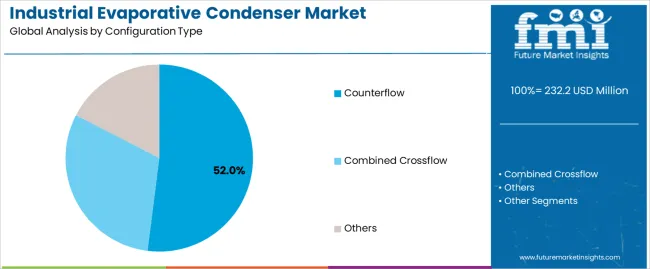
Market Position: Counterflow condenser systems command the leading position in the industrial evaporative condenser market with 52% market share through proven heat transfer technologies, including optimized airflow design, enhanced cooling efficiency, and thermal performance optimization that enable industrial operators to achieve optimal process cooling across diverse manufacturing and processing environments.
Value Drivers: The segment benefits from industrial preference for reliable cooling systems that provide consistent thermal performance, energy efficiency, and operational durability without requiring complex multi-stage infrastructure. Advanced counterflow design features enable enhanced heat transfer, reduced water consumption, and integration with existing cooling programs, where thermal efficiency and process reliability represent critical operational requirements.
Competitive Advantages: Counterflow condenser systems differentiate through proven thermal reliability, optimized heat transfer characteristics, and integration with established industrial cooling systems that enhance facility effectiveness while maintaining optimal process temperatures suitable for diverse industrial applications.
Key market characteristics:
Combined crossflow condenser systems maintain a 31% market position in the industrial evaporative condenser market due to their multi-stage advantages and enhanced cooling capabilities. These systems appeal to facilities requiring sophisticated cooling solutions with advanced thermal profiles for complex industrial operations. Market growth is driven by process industry expansion, emphasizing high-performance cooling solutions and operational efficiency through optimized heat transfer designs.
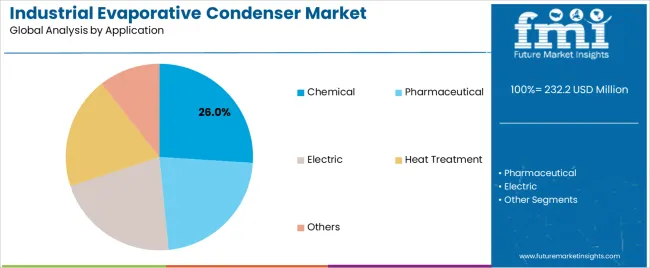
Market Context: Chemical processing applications demonstrate strong growth in the industrial evaporative condenser market with 7.2% CAGR and 26% market share due to widespread adoption of advanced cooling systems and increasing focus on process efficiency, energy optimization, and temperature control applications that maximize cooling effectiveness while maintaining industrial standards.
Appeal Factors: Chemical processors prioritize cooling reliability, thermal consistency, and integration with existing process infrastructure that enables coordinated cooling operations across multiple production departments. The segment benefits from substantial chemical industry investment and modernization programs that emphasize the acquisition of high-efficiency condensers for process optimization and energy management applications.
Growth Drivers: Chemical facility expansion programs incorporate evaporative condensers as essential components for process cooling, while industrial growth increases demand for cooling capabilities that comply with process requirements and minimize energy consumption.
Market Challenges: Varying process requirements and operational scale complexity may limit cooling standardization across different chemical facilities or production scenarios.
Application dynamics include:
Pharmaceutical manufacturing applications capture 24% market share through specialized temperature control requirements in drug manufacturing facilities, biotechnology companies, and pharmaceutical applications. These facilities demand precision condensers capable of supporting GMP requirements while providing temperature control access and process reliability capabilities.
Electric power generation applications account for 20% market share, including utility facilities, power plants, and energy operations requiring high-capacity cooling capabilities for power optimization and operational effectiveness.
Market Context: Process Manufacturing Facilities dominate the industrial evaporative condenser market with a 6.8% CAGR, reflecting the primary demand source for industrial evaporative condenser technology in manufacturing applications and process optimization.
Business Model Advantages: Process Manufacturing Facilities provide direct market demand for standardized cooling systems, driving volume production and cost optimization while maintaining quality control and process efficiency requirements.
Operational Benefits: Process Manufacturing applications include temperature standardization, energy efficiency, and quality assurance that drive consistent demand for cooling systems while providing access to latest thermal technologies.
| Category | Factor | Impact | Why It Matters |
|---|---|---|---|
| Driver | Industrial modernization & energy efficiency requirements (process optimization, cost reduction) | ★★★★★ | Growing industrial sector requires efficient cooling systems with enhanced thermal performance and energy optimization proven effective across manufacturing applications. |
| Driver | Environmental regulations & water conservation (sustainability standards, resource efficiency) | ★★★★★ | Transforms cooling requirements from "basic heat rejection" to "efficient thermal management"; operators that offer energy-efficient condensers and compliance features gain competitive advantage. |
| Driver | Process industry expansion & capacity growth (chemical plants, pharmaceutical facilities) | ★★★★☆ | Industrial facilities need reliable, high-capacity cooling systems; demand for robust and efficient cooling solutions expanding addressable market. |
| Restraint | High capital costs & installation complexity (especially for smaller facilities) | ★★★★☆ | Smaller industrial operators defer cooling system upgrades; increases price sensitivity and slows advanced condenser adoption in cost-conscious markets. |
| Restraint | Alternative cooling technology competition (air-cooled systems, hybrid solutions) | ★★★☆☆ | Alternative cooling technologies offer established supply chains and different cost structures, potentially limiting evaporative condenser adoption in specific applications. |
| Trend | Smart monitoring integration & predictive maintenance (IoT sensors, performance analytics) | ★★★★★ | Advanced monitoring capabilities, efficiency optimization, and predictive analytics transform operations; technology integration and performance enhancement become core value propositions. |
| Trend | Customization & application-specific solutions (process integration, specialized designs) | ★★★★☆ | Custom condensers for specific industrial applications; specialized designs and targeted cooling capabilities drive competition toward customization solutions. |
The industrial evaporative condenser market demonstrates varied regional dynamics with Growth Leaders including China (7.56% growth rate) and India (7.0% growth rate) driving expansion through industrial development initiatives and manufacturing sector modernization. Steady Performers encompass Germany (6.44% growth rate), Brazil (5.88% growth rate), and developed regions, benefiting from established industrial infrastructure and advanced cooling system adoption. Mature Markets feature United States (5.32% growth rate), United Kingdom (4.76% growth rate), and Japan (4.2% growth rate), where industrial advancement and energy efficiency requirements support consistent growth patterns.
Regional synthesis reveals East Asian markets leading adoption through industrial expansion and manufacturing development, while North American countries maintain steady expansion supported by cooling technology advancement and energy efficiency requirements. European markets show strong growth driven by industrial applications and efficiency integration trends.
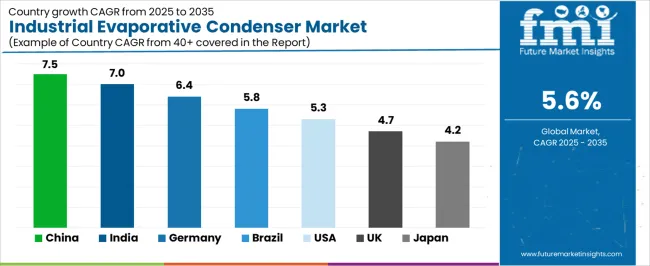
| Region/Country | 2025-2035 Growth | How to win | What to watch out |
|---|---|---|---|
| China | 7.5 | Focus on large-scale industrial solutions | Regulatory changes; local competition |
| India | 7.0 | Lead with cost-effective manufacturing solutions | Import restrictions; infrastructure barriers |
| Germany | 6.4 | Provide premium efficiency systems | Over-regulation; lengthy approvals |
| Brazil | 5.8 | Offer value-oriented industrial solutions | Currency fluctuations; import duties |
| United States | 5.3 | Push technology integration | Compliance costs; scaling challenges |
| United Kingdom | 4.7 | Focus on efficiency applications | Economic impacts; energy costs |
| Japan | 4.2 | Emphasize precision manufacturing | Traditional preferences; adoption rates |
China establishes fastest market growth through aggressive industrial development programs and comprehensive manufacturing sector expansion, integrating advanced evaporative condenser systems as standard components in chemical facilities and industrial installations. The country's 7.5% growth rate reflects government initiatives promoting industrial infrastructure and domestic cooling capabilities that mandate the use of efficient cooling systems in manufacturing and processing facilities. Growth concentrates in major industrial hubs, including Shanghai, Guangzhou, and Tianjin, where industrial development showcases integrated cooling systems that appeal to manufacturers seeking thermal management optimization capabilities and operational applications.
Chinese manufacturers are developing cost-effective cooling solutions that combine domestic production advantages with advanced thermal features, including enhanced efficiency control and improved performance capabilities. Distribution channels through industrial suppliers and equipment distributors expand market access, while government support for industrial development supports adoption across diverse manufacturing and processing segments.
Strategic Market Indicators:
In Mumbai, Delhi, and Chennai, industrial facilities and manufacturing operators are implementing advanced evaporative condenser systems as standard equipment for process cooling and thermal management applications, driven by increasing government industrial investment and manufacturing modernization programs that emphasize the importance of energy efficiency capabilities. The industrial evaporative condenser market holds a 7.0% growth rate, supported by government industrial initiatives and manufacturing development programs that promote efficient cooling systems for industrial and processing facilities. Indian operators are adopting cooling systems that provide consistent thermal performance and energy features, particularly appealing in industrial regions where process efficiency and operational excellence represent critical business requirements.
Market expansion benefits from growing industrial capabilities and international manufacturing partnerships that enable domestic production of advanced cooling systems for industrial and processing applications. Technology adoption follows patterns established in industrial equipment, where reliability and efficiency drive procurement decisions and operational deployment.
Market Intelligence Brief:
Germany's advanced industrial market demonstrates sophisticated evaporative condenser deployment with documented thermal effectiveness in chemical applications and manufacturing facilities through integration with existing industrial systems and operational infrastructure. The country leverages engineering expertise in thermal systems and process integration to maintain a 6.4% growth rate. Industrial centers, including North Rhine-Westphalia, Bavaria, and Baden-Württemberg, showcase premium installations where cooling systems integrate with comprehensive process platforms and facility management systems to optimize thermal performance and operational effectiveness.
German manufacturers prioritize system quality and EU compliance in cooling development, creating demand for premium systems with advanced features, including facility integration and thermal management systems. The industrial evaporative condenser market benefits from established industrial infrastructure and a willingness to invest in efficient cooling technologies that provide long-term operational benefits and compliance with international industrial standards.
Market Intelligence Brief:
Brazil's market expansion benefits from diverse industrial demand, including manufacturing modernization in São Paulo and Rio de Janeiro, industrial facility upgrades, and government industrial programs that increasingly incorporate efficient cooling solutions for process applications. The country maintains a 5.8% growth rate, driven by rising manufacturing activity and increasing recognition of efficient cooling benefits, including precise thermal control and enhanced operational effectiveness.
Market dynamics focus on cost-effective cooling solutions that balance thermal performance with affordability considerations important to Brazilian industrial operators. Growing manufacturing industrialization creates continued demand for modern cooling systems in new industrial infrastructure and facility modernization projects.
Strategic Market Considerations:
The United States establishes market leadership through comprehensive industrial programs and advanced manufacturing infrastructure development, integrating evaporative condenser systems across chemical and processing applications. The country's 5.3% growth rate reflects established industrial relationships and mature cooling technology adoption that supports widespread use of efficient cooling systems in manufacturing and processing facilities. Growth concentrates in major industrial centers, including Texas, Louisiana, and California, where cooling technology showcases mature deployment that appeals to industrial operators seeking proven thermal capabilities and operational efficiency applications.
American industrial providers leverage established distribution networks and comprehensive technical support capabilities, including system design programs and engineering support that create customer relationships and operational advantages. The industrial evaporative condenser market benefits from mature regulatory standards and industrial requirements that mandate cooling system use while supporting technology advancement and operational optimization.
Market Intelligence Brief:
United Kingdom's industrial market demonstrates integrated evaporative condenser deployment with documented thermal effectiveness in chemical applications and manufacturing facilities through integration with existing industrial systems and operational infrastructure. The country maintains a 4.7% growth rate, supported by industrial efficiency programs and thermal effectiveness requirements that promote efficient cooling systems for industrial applications. Manufacturing facilities across England, Scotland, and Wales showcase systematic installations where cooling systems integrate with comprehensive industrial platforms to optimize thermal performance and operational outcomes.
UK industrial providers prioritize system reliability and industry compatibility in cooling procurement, creating demand for validated systems with proven thermal features, including efficiency monitoring integration and thermal management systems. The industrial evaporative condenser market benefits from established industrial infrastructure and efficiency requirements that support cooling technology adoption and operational effectiveness.
Market Intelligence Brief:
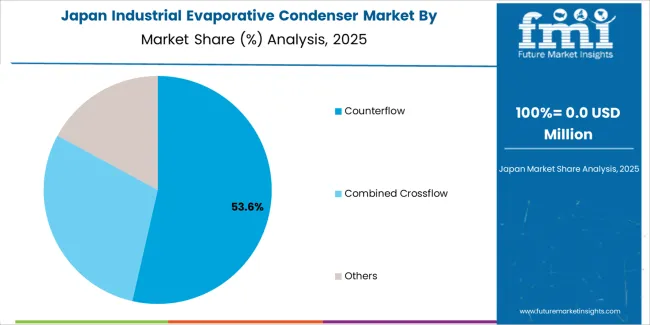
Japan's market growth benefits from precision industrial demand, including advanced manufacturing facilities in Tokyo and Osaka, quality integration, and efficiency enhancement programs that increasingly incorporate cooling solutions for thermal applications. The country maintains a 4.2% growth rate, driven by industrial technology advancement and increasing recognition of precision cooling benefits, including accurate thermal control and enhanced process outcomes.
Market dynamics focus on high-precision cooling solutions that meet Japanese quality standards and thermal effectiveness requirements important to industrial operators. Advanced industrial technology adoption creates continued demand for sophisticated cooling systems in manufacturing facility infrastructure and process modernization projects.
Strategic Market Considerations:
The European industrial evaporative condenser market is projected to grow from USD 51.4 million in 2025 to USD 88.9 million by 2035, registering a CAGR of 5.6% over the forecast period. Germany is expected to maintain its leadership position with a 42.1% market share in 2025, supported by its advanced industrial infrastructure and major manufacturing centers.
United Kingdom follows with a 26.8% share in 2025, driven by comprehensive industrial programs and efficiency development initiatives. France holds a 16.2% share through specialized industrial applications and process compliance requirements. Italy commands a 9.7% share, while Spain accounts for 5.2% in 2025. The rest of Europe region is anticipated to gain momentum, expanding its collective share from 4.1% to 4.8% by 2035, attributed to increasing industrial adoption in Nordic countries and emerging manufacturing facilities implementing industrial modernization programs.
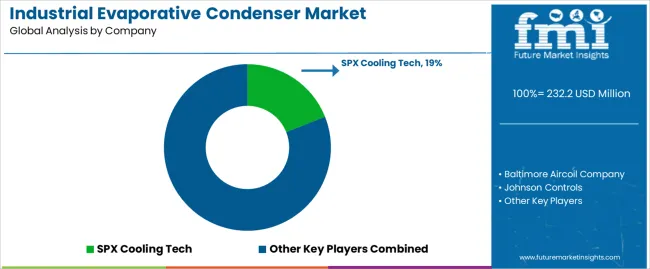
| Stakeholder | What they actually control | Typical strengths | Typical blind spots |
|---|---|---|---|
| Global brands | Distribution reach, broad product catalogs, brand recognition | Wide availability, proven quality, multi-region support | Product refresh cycles; customer dependency on brand validation |
| Technology innovators | Thermal R&D; advanced cooling technologies; enhanced performance properties | Latest technologies first; attractive ROI on efficiency effectiveness | Service density outside core regions; scaling complexity |
| Regional specialists | Local compliance, fast delivery, nearby customer support | "Close to customer" support; pragmatic pricing; local regulations | Technology gaps; talent retention in customer service |
| Full-service providers | Cooling programs, design services, installation management | Lowest operational risk; comprehensive support | Service costs if overpromised; technology obsolescence |
| Niche specialists | Specialized applications, custom systems, process services | Win premium applications; flexible configurations | Scalability limitations; narrow market focus |
| Item | Value |
|---|---|
| Quantitative Units | USD 232.2 million |
| Configuration Type | Counterflow, Combined Crossflow, Others |
| Application | Chemical, Pharmaceutical, Electric, Heat Treatment, Others |
| End Use | Process Manufacturing Facilities, Power Plants, Chemical Refineries, Pharmaceutical Companies, Industrial Cooling Contractors |
| Regions Covered | North America, Latin America, Western Europe, Eastern Europe, East Asia, South Asia Pacific, Middle East & Africa |
| Countries Covered | China, India, Germany, Brazil, United States, United Kingdom, Japan, Canada, France, Australia, and 25+ additional countries |
| Key Companies Profiled | SPX Cooling Tech, Baltimore Aircoil Company, Johnson Controls, evAPCO, Enex Industrial, MITA Cooling Technologies, Aonaer, Dasen-Cooling, HF Technology |
| Additional Attributes | Dollar sales by configuration type and application categories, regional adoption trends across East Asia, North America, and Western Europe, competitive landscape with cooling equipment manufacturers and system suppliers, industrial operator preferences for cooling effectiveness and thermal performance, integration with industrial platforms and process control systems, innovations in thermal technology and cooling enhancement, and development of advanced cooling solutions with enhanced efficiency and operational optimization capabilities. |
The global industrial evaporative condenser market is estimated to be valued at USD 232.2 million in 2025.
The market size for the industrial evaporative condenser market is projected to reach USD 400.4 million by 2035.
The industrial evaporative condenser market is expected to grow at a 5.6% CAGR between 2025 and 2035.
The key product types in industrial evaporative condenser market are counterflow, combined crossflow and others.
In terms of application, chemical segment to command 26.0% share in the industrial evaporative condenser market in 2025.






Full Research Suite comprises of:
Market outlook & trends analysis
Interviews & case studies
Strategic recommendations
Vendor profiles & capabilities analysis
5-year forecasts
8 regions and 60+ country-level data splits
Market segment data splits
12 months of continuous data updates
DELIVERED AS:
PDF EXCEL ONLINE
Industrial Power Supply Market Size and Share Forecast Outlook 2025 to 2035
Industrial Crystallizer Market Size and Share Forecast Outlook 2025 to 2035
Industrial Counterweight Market Size and Share Forecast Outlook 2025 to 2035
Industrial Gas Market Size and Share Forecast Outlook 2025 to 2035
Industrial Furnace Market Size and Share Forecast Outlook 2025 to 2035
Industrial Weighing Equipment Market Size and Share Forecast Outlook 2025 to 2035
Industrial Drum Market Size and Share Forecast Outlook 2025 to 2035
Industrial Food Slicers Market Size and Share Forecast Outlook 2025 to 2035
Industrial Printer Market Size and Share Forecast Outlook 2025 to 2035
Industrial Fryers Market Size and Share Forecast Outlook 2025 to 2035
Industrial Paper Sacks Market Size and Share Forecast Outlook 2025 to 2035
Industrial Chemical Packaging Market Size and Share Forecast Outlook 2025 to 2035
Industrial Adhesives Market Size and Share Forecast Outlook 2025 to 2035
Industrial Valve Market Size and Share Forecast Outlook 2025 to 2035
Industrial Air Filtration Market Size and Share Forecast Outlook 2025 to 2035
Industrial Phosphates Market Size and Share Forecast Outlook 2025 to 2035
Industrial Elevators Market Size and Share Forecast Outlook 2025 to 2035
Industrial Boilers Market Size and Share Forecast Outlook 2025 to 2035
Industrial Battery Market Size and Share Forecast Outlook 2025 to 2035
Industrial Nailers Market Size and Share Forecast Outlook 2025 to 2035

Thank you!
You will receive an email from our Business Development Manager. Please be sure to check your SPAM/JUNK folder too.
Chat With
MaRIA